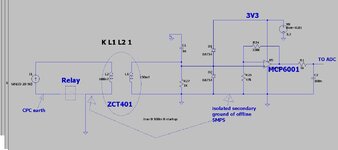cupoftea
Advanced Member level 5
Hi,
Our contractor has used the ZCT401 CT to measure the current flowing from the CPC earth, to the secondary ground of our circuit (normally, of course, there should be zero current in this connection).
This is a mains distribution box, so the CPC goes straight through it to the load. The secondary ground is the secondary of an isolated SMPS which uses the disty box's mains connection to produce a secondary 24V which gets used by the disty box internal electronics.
In fact, we use a relay to connect the CPC earth and the isolated secondary ground......and this then also switchs in the said CT which then measures any current flow between these two nodes.
The ZCT401 is a "zero phase current transformer", and as such, why is it so suitable for measuring the current in a single 50Hz mains conductor?
The datasheet says "22.5mA". Is this the current that flows in the ZCT401 secondary when its used as a "imbalance torroid" and there's 22.5mA of imbalance?
The attached is how our contractor wants to use it. Do you know what is the turns ratio of the ZCT401 so we can calculate the current in the BAT54's if high fault current flows?
Why hasnt the contractor rectified the ZCT401 output?
ZCT401 datasheet
The reay is HF170F
...A 35A, 250VAC relay
Our contractor has used the ZCT401 CT to measure the current flowing from the CPC earth, to the secondary ground of our circuit (normally, of course, there should be zero current in this connection).
This is a mains distribution box, so the CPC goes straight through it to the load. The secondary ground is the secondary of an isolated SMPS which uses the disty box's mains connection to produce a secondary 24V which gets used by the disty box internal electronics.
In fact, we use a relay to connect the CPC earth and the isolated secondary ground......and this then also switchs in the said CT which then measures any current flow between these two nodes.
The ZCT401 is a "zero phase current transformer", and as such, why is it so suitable for measuring the current in a single 50Hz mains conductor?
The datasheet says "22.5mA". Is this the current that flows in the ZCT401 secondary when its used as a "imbalance torroid" and there's 22.5mA of imbalance?
The attached is how our contractor wants to use it. Do you know what is the turns ratio of the ZCT401 so we can calculate the current in the BAT54's if high fault current flows?
Why hasnt the contractor rectified the ZCT401 output?
ZCT401 datasheet
Zero phase current transformer - Xiamen ZTC Technology Co.,Ltd
Differential current sensor, zero phase current transformer made by Xiamen ZTC Technology Co.,Ltd is widely used in EV charging Module, GFCI, RCD.
www.cnzentar.com
--- Updated ---
The reay is HF170F
...A 35A, 250VAC relay
Attachments
Last edited:
